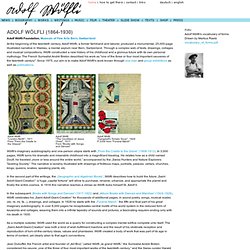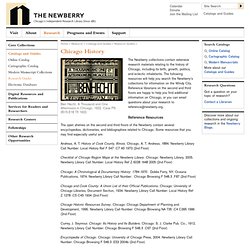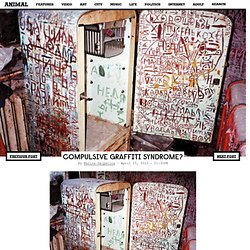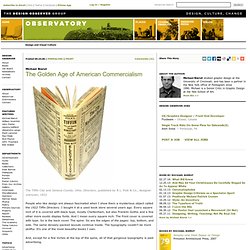

McKenzie Fine Art: Horror Vacui. Hypergraphia, Graphomania and the Voynich Manuscript. Have been interested in the obsessive impulse to produce script, especially when the script is a succession of meaningless but repetitive symbols. As a psychological disorder, graphomania is closely associated with schizophrenia and obsessive compulsive disorder. Lewis Carrol, Dostoevsky and van Gogh were all said to have exhibited graphomania in their notebooks. Lewis Carrol often wrote backwards, upside-down, in circles, etc. An example: The most famous graphomaniac, however, is likely Robert Crumb's brother, Charles, whose comics were at one point completely overtaken by the script: Graphomania is characterized by specifically meaningless script.
An example from "Midnight Disease" a book by Alice Flaherty on Hypergraphia: An example from Max Ernst suggests an alien language: The Voynich manuscript surfaced sometime in the 15th century. The Voynich Manuscript is at the Beinecke, Yale's Rare Books library. ASCII Art Generator - Make your picture into text. Adolf Wölfli: home. At the beginning of the twentieth century, Adolf Wölfli, a former farmhand and laborer, produced a monumental, 25,000-page illustrated narrative in Waldau, a mental asylum near Bern, Switzerland.

Through a complex web of texts, drawings, collages and musical compositions, Wölfli constructed a new history of his childhood and a glorious future with its own personal mythology. The French Surrealist André Breton described his work as "one of the three or four most important oeuveres of the twentieth century". Since 1975, our aim is to make Adolf Wölfli's work known through one-man and group exhibitions as well as publications.
Wölfli's imaginary autobiography and one-person utopia starts with „From the Cradle to the Grave“ (1908-1912). Adolf Wölfli. Portrait of Adolf Wölfli Adolf Wölfli (February 29, 1864 – November 6, 1930) (occasionally spelled Adolf Woelfli or Adolf Wolfli) was a Swiss artist who was one of the first artists to be associated with the Art Brut or outsider art label. Early life[edit] Wölfli was born in Bern. He was abused both physically and sexually as a child, and was orphaned at the age of 10. He thereafter grew up in a series of state-run foster homes. Creative works[edit] At some point after his admission Wölfli began to draw. Walter Morgenthaler, a doctor at the Waldau Clinic, took a particular interest in Wölfli's art and his condition, later publishing Ein Geisteskranker als Künstler (A Psychiatric Patient as Artist) in 1921 which first brought Wölfli to the attention of the art world.
Wölfli's Irren-Anstalt Band-Hain, 1910 "Every Monday morning Wölfli is given a new pencil and two large sheets of unprinted newsprint. General view of the island Neveranger, 1911 Music and audio recordings[edit] 1. 7. 10. The Art Bulletin, Vol. 67, No. 3 (Sep., 1985), pp. 486-500. Chicago History. The Newberry collections contain extensive research materials relating to the history of Chicago, including its birth, growth, politics, and eclectic inhabitants.

The following resources will help you search the Newberry’s collections for information on the Windy City. Reference librarians on the second and third floors are happy to help you find additional information on Chicago, or you can email questions about your research to reference@newberry.org. The open shelves on the second and third floors of the Newberry contain several encyclopedias, dictionaries, and bibliographies related to Chicago. Some resources that you may find especially useful are: Tremulous Analysis by *Quaddles-Roost on deviantART. Compulsive Graffiti Syndrome? A certain artistic Ukrainian gentleman by the name of Mitasov lived here, covering his apartment in layers and layers of inscriptions.

He was university educated in economics and managed a store, but he also had something called horror vacui — “fear of blank or empty spaces” — a hyper-obsessive personality disorder strain causing him to scrawl his walls, his fridge, his piano. He also did street art. He had to. You can still see them around in Ukraine, like “Happiness! I’m waiting for you here!” Here’s a glimpse at his body of work. The Golden Age of American Commercialism. The Tiffin City and Seneca County, Ohio, Directory, published by R.L.

Polk & Co., designer unknown, 1922 People who like design are always fascinated when I show them a mysterious object called the 1922 Tiffin Directory. I bought it at a used book store several years ago. Every square inch of it is covered with black type, mostly Cheltenham, but also Franklin Gothic and a few other more exotic display fonts. And I mean every square inch. And, except for a few inches at the top of the spine, all of that gorgeous typography is paid advertising. Although I've never seen another like it, I've been told books like the Tiffin Directory were common in the first quarter of the twentieth century. If you want a soundtrack for the era, you could do worse than the The Music Man, Meredith Willson's 1957 musical set in a mythical pre-WWI Iowa town that falls under the spell of a huckster selling marching band instruments. Graff1.jpeg (600×457)